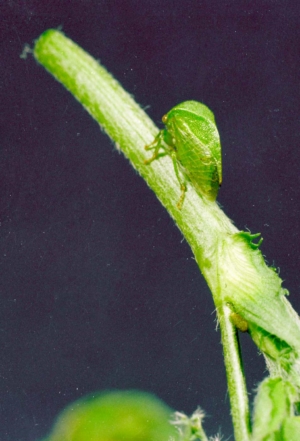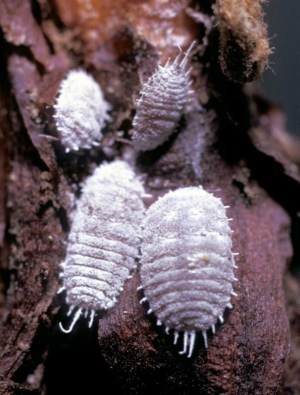
The buffalo treehopper was a pear pest decades ago before powerful insecticides drove it out of orchards. Now researchers are checking to see if the bug is a carrier of the virus that causes red blotch disease in Washington vineyards. (Courtesy Whitney Cranshaw, Colorado State University)
In their search for vectors for grapevine red blotch disease in Washington, researchers discovered two treehoppers in the same Membracidae family as a known vector in California, including one that warrants further research as a potential carrier of the disease.
Since being first recognized in 2008 in a Napa Valley, California, vineyard, red blotch-associated virus or red blotch disease has spread to many major grape production regions of the U.S. and Canada. Researchers identified the three-cornered alfalfa treehopper as a vector in California in 2016, but cautioned that it’s unlikely it’s the only one.

The three-cornered alfalfa treehopper is a known vector of red blotch disease in California. But a search for the pest in Washington turned up empty. (Courtesy USDA Cooperative Extension, Clemson University)
Three-cornered alfalfa treehopper has never been reported in Washington, and intensive sampling throughout Central Washington last year didn’t find any, as expected.
But it did show enough buffalo treehoppers — all adults — to warrant further research as a suspect insect, said Washington State University entomologist Doug Walsh.
The buffalo treehopper was identified in historical literature as a pear pest in the 1930s and ’40s at the Tree Fruit Research and Extension Center in Wenatchee, Washington.
Like a lot of secondary pests, it disappeared when orchardists got powerful insecticides to combat primary pests.
“They’re in the same family (as the three-cornered alfalfa treehoppers), and one would expect if one member of the family is vectoring the disease, chances are a fairly closely related species would as well,” he said.
The treehoppers were found in a number of locations: alfalfa, weed and riparian habitat and pear orchards. None were found in vineyards.
“That would imply to us that grapes are not a preferred host for the buffalo treehopper,” he said. “The same thing is true for the three-cornered treehopper, but California vineyard managers are saying that since they’ve had a drought for so many years, most of the ground cover in the vineyards had dried up, so the insects didn’t really have a choice.”
Treehoppers are a particular concern following research by Brian Bahder, a former graduate student of Walsh’s. While an entomology postdoctoral researcher at the University of California, Davis, Bahder discovered in transmission assays that just one three-cornered alfalfa treehopper could transmit the disease about half the time on a clean grapevine over just two days.
Bahder is now an assistant professor at the University of Florida.
One other treehopper, Palonica, was also found in the Washington surveys, but only two of the insects were caught, both in riparian habitat along Central Washington’s Yakima River.
This year, WSU researchers aim to continue to conduct field surveys, both for the treehoppers themselves and to try to determine the host plants insects are developing in through immature stages, Walsh said. They also will conduct transmission assays following similar protocols as those developed by Bahder.
“The reality is that we should start looking,” Walsh said. “I can’t say the disease is not moving or spreading, it’s just not spreading anywhere near as rapidly as it is in California or even Oregon. In Washington, we seem to be living a charmed life for the time being.” •
Grape mealybug research continues

Grape mealybug, Pseudococcus maritimus. (Courtesy USDA Agricultural Research Service)
Several years ago, researchers at Washington State University researched whether the grape mealybug is a vector for grapevine leafroll disease.
Turns out, the mealybug is a vector, but researchers in California beat them to the discovery.
So former WSU graduate student Brian Bahder turned his focus to determining how the bugs acquire the disease. He showed that mealybugs could acquire the virus in either Concord or wine grapes and transmit it between the two.
Graduate student Jonathan O’Hearn now is working with Walsh to try to determine how big a population of mealybugs is needed to vector disease.
Bahder’s research involved putting 10 infected mealybugs on a clean plant, resulting in transmission 30 to 40 percent of the time.
In 2017, O’Hearn dropped the number of infected crawlers to five bugs per plant in one study, and to one bug per plant in another. Now, it’s a waiting game to determine rates of infection.
O’Hearn and Walsh also are working to see if there is a titer of insecticide great enough to prevent mealybugs from feeding on grapevines without damaging grapes or pushing the crop over the insecticide tolerance range.
“We’d like to get back to a true management program, based on thresholds, that’s not calendar based,” Walsh said. “And we’re trying to come up with an action threshold for mealybugs. If it comes down to one mealybug is enough to spread virus, then I’ll toss in the towel.”
Rearing in the pumpkin patch
Grape mealybugs have a fairly wide host range, from pears to grapes, but no one had figured out how to mass rear them for research purposes. Until now.
WSU graduate student Jonathan O’Hearn discovered last year that the insects proliferate in pumpkins. However, downy mildew struck down his pumpkin patch following problems controlling climate in the greenhouse, hampering his research.
A constraint in mealybug research is having enough crawlers to conduct research trials, Walsh said, and O’Hearn found a way to mass rear them. “This has proved handy and helpful in the research.”
—by Shannon Dininny






Leave A Comment